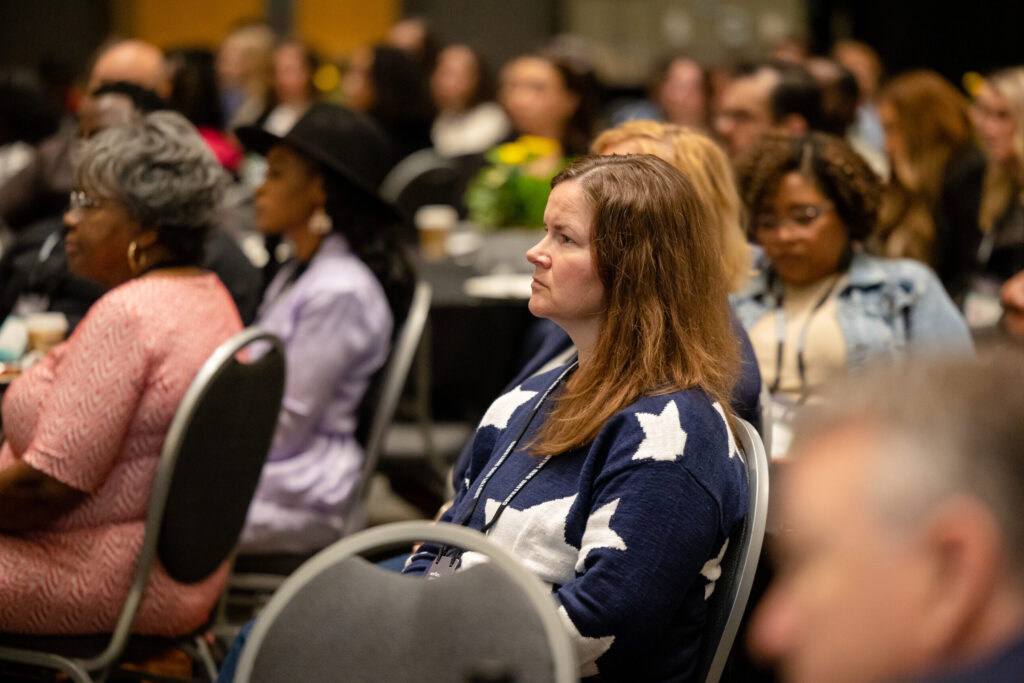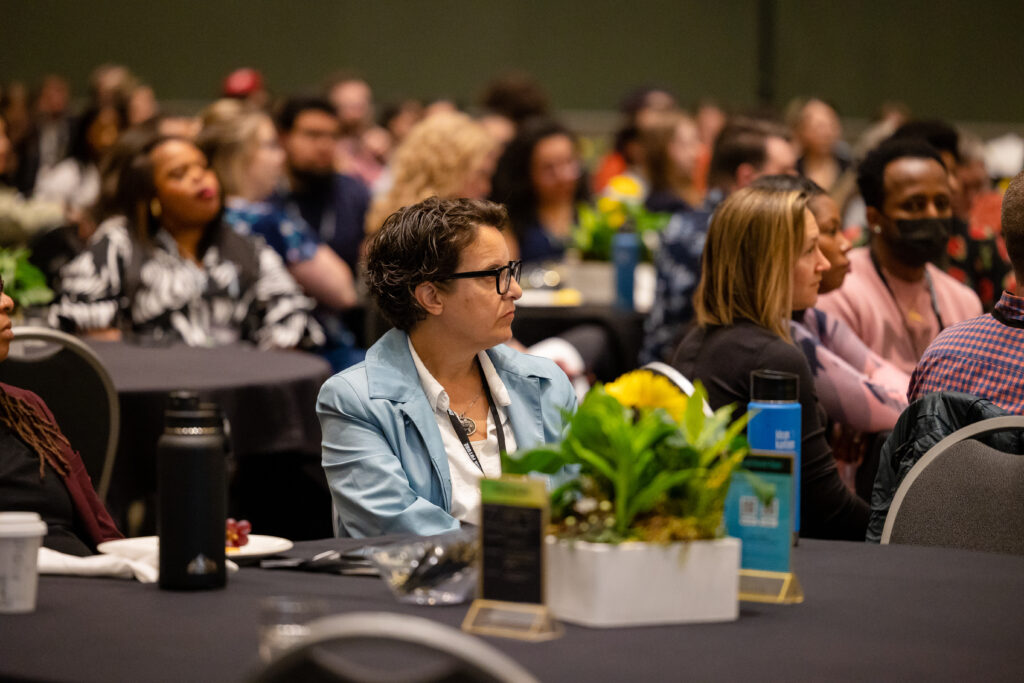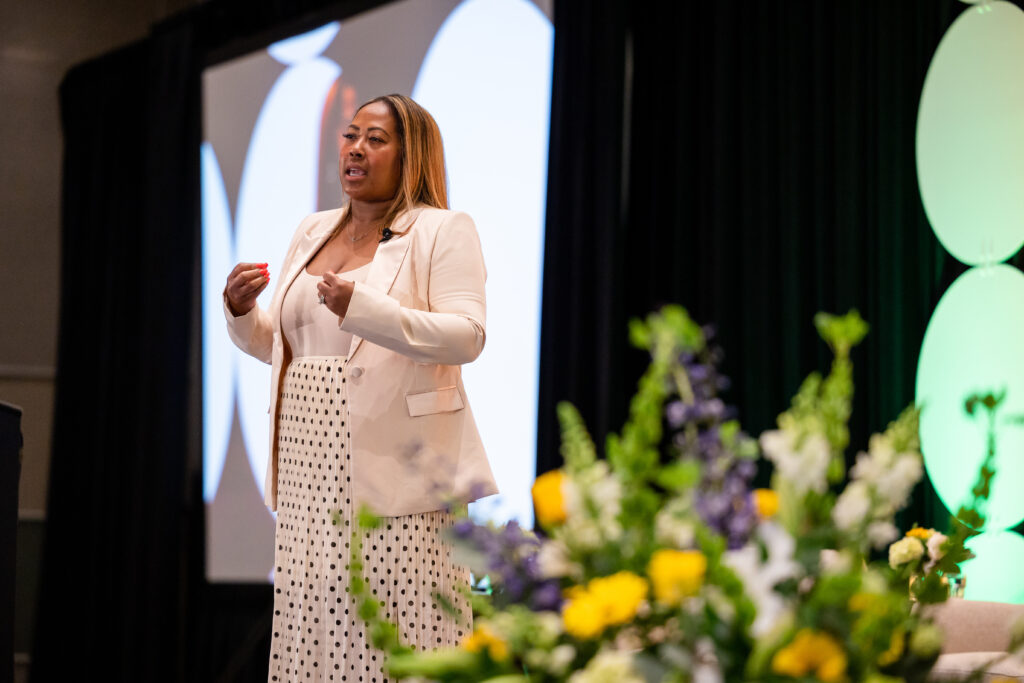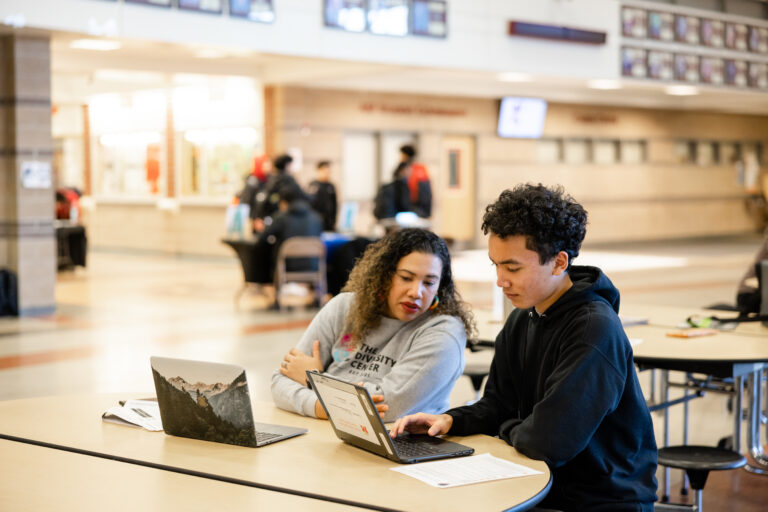The Foundation for Tacoma Students hosted its fourth annual Charting Our Future conference, a transformative gathering that brought together over 300 educators, policymakers, community leaders, and advocates committed to creating a more equitable and effective education system for all students. This year’s theme, “Local Focus, Statewide Impact,” underscored the power of community-driven initiatives to catalyze systemic change and improve outcomes for students across Washington. In her opening address, Dr. Tafona Ervin, Executive Director of the Foundation, reminds us that transformative change starts with the work we do every day in our schools, organizations, and neighborhoods, and that we must also think systemically and work collaboratively to achieve equity in education.
Dr. Ervin emphasized the responsibility and interconnectedness of early learning, expanded learning, K-12, higher education, and workforce and the importance of viewing these as a cohesive journey rather than isolated stages in a child’s journey to adulthood. Dr. Ervin’s speech serves as a clarion call to action for rethinking our approaches and systems to better support every child’s potential at each stage.
Below is the full transcript of Dr. Tafona Ervin’s remarks during the conference. We hope these insights will spark ongoing conversation, reflection, and action as we work together to build a brighter future for all students.
“Education stands as the cornerstone of opportunity. Yet, often, the very systems designed to empower us fail our most vulnerable. Today, I speak before you not just as a witness but as someone deeply impacted by these systems—justice, healthcare, education, and housing. These aren’t abstract concepts; they are the fabric of my existence and the reality for those I hold dear.
I know too well the stark reality of what happens when these systems are not connected; when they fail to provide for those who need it most
Among my grandmother’s eight children, four fell victim to a system that failed to protect them. Two more are currently being harmed by a system blind to their worth. And the remaining two, despite navigating through the many obstacles consistently placed in front of them, are doing so at a high personal cost, where till this day, hard decisions between purchasing food or refilling required prescription medication are the hard choices they are faced with.
This is not the tale of a few isolated individuals, but a mirror to many in our community, reflecting the experiences of countless others affected by a flawed system. It’s easy to dismiss these systemic failures by claiming a lack of resources. But let’s be honest – it’s not always about resources. It’s about a lack of willingness – a reluctance to envision and embrace a different way; a resistance to change.
We’ve become accustomed to saying, “This is just how the system works,” without questioning whether it should work that way at all. We’ve grown complacent, comfortable with the status quo, even as it fails those most in need – generation after generation.
As we stand at this crossroads, and I reflect on the role of our elected officials, particularly those among you who have shown a steadfast commitment to this cause, I offer my deep appreciation for your efforts. Yet, despite your dedication, we often find that the broader system does not fully allow us to harness our collective ability and capacity to drive progress. Even well intentioned leaders find themselves stalled by the slow grind of bureaucracy.
Our plea is urgent: young people are paying with their lives for our hesitations and missteps. This is unacceptable.
It’s important to remember that we are all integral parts of this larger system. Each of us hopes to affect change through our unique experiences and insights, which are invaluable in transforming these systems. And we bring to this work solutions we believe will affect the very change we desire based on our unique experiences and insights. And our commitments can be demonstrated through collaborative strategies to realize our community’s 2030 goal, like that of Pierce County Pathways or our collective efforts to influence state legislators to rethink their approaches to policy, law, and resourcing in the broader education ecosystem.

It’s clear that we cannot afford to remain bystanders in this process. We must actively engage as catalysts for change. We are proving through our actions that local efforts can indeed reshape the landscape of opportunity statewide. We are not just participants in this conversation, we are the blueprint for change.
But change cannot happen in isolation. It requires each of us to recognize our agency and our role in shaping our communities and our futures. Yet for reasons of old habits die hard, too often, we think that certain things are not our job, that we can’t do them, or that we don’t have a place in them.
But let me remind you that during the pandemic, we made a swift systemic change—we demonstrated how quickly we can adapt when united by a common goal. We know it’s possible and we know that we are capable. Yet, as the urgency wanes, we revert to old, ineffective habits. We cannot afford to regress.There is an imperative for us to take action, even when we feel stuck and uncertain of where to go.
I want to acknowledge the duality of our reality – a space where optimism and cynicism coexist. A space that I live in every single day. A space where optimism fuels our endeavors, and where cynicism stalls our progress because of the daunting reality of just how complex our systems really are. Both truths live within us. But it is up to us to determine which truth will ultimately prevail.
In the flurry of our daily tasks and the intricate processes of our work, it’s all too easy to lose sight of the grand vision that unites us. We must remember that our efforts are not merely for the completion of tasks but are in service to a far greater cause. But we cannot allow ourselves to be so bogged down in the details that we lose our ability to dream—to dream boldly and courageously.
As leaders and changemakers within this vibrant ecosystem, dreaming should not be a luxury. It should be a fundamental part of how we operate. We must not be afraid to envision a brighter and bolder future—because if we don’t dream it, who will? The aspirations we have for our children, our community, and our society – this vision must not be a passive backdrop to our efforts but the very force that drives them.
We must shift from reactive short-term fixes to a mindset of sustained, proactive engagement. It’s not merely about putting out fires—it’s about lighting a path forward.
Let us commit to renewed focus on proactive strategies, collaborative efforts, and clear communication. Let us move forward, not in isolation but as a unified front, advancing towards a shared, meaningful, and transformative goal.
We know that challenges which appear straightforward from a distance can reveal their complexities and nuance up close.
From the elevated vantage point of the balcony, the path forward seems clear and the solution appears easy. But this perspective is an illusion of simplicity, afforded only by those who observe from a distance.
Here on the ground, in the thick of action – what I call ‘the dance floor’ – reality tells a different story. Here, it’s not just about moving left or right. Here, you navigate through unexpected obstacles. The path forward is never straightforward and it requires the insights and experiences of those among us who navigate these complexities every day.
Today, we gather with a focus that is both local and not unique to us in Tacoma. Our commitment to understanding the nuances of our communities not only deepens our wherewithal of the many obstacles community are faced with, but critically enhances our effectiveness as we push toward real, tangible solutions that can have statewide impact.
The decentralized governance structure of Washington’s education system offers undeniable advantages, allowing local school districts the flexibility to meet the distinct needs of their communities. This approach fosters innovation and responsiveness—what succeeds in Spokane may not suit Tacoma, and our system allows for this diversity
However, this flexibility also presents significant challenges. Governance that is too loosely defined lacks a framework for shared accountability. Each district, acting independently, follows its own compass. And yet, despite these varied approaches, the outcomes across our state are consistently disappointing. Students continue to struggle with basic educational milestones, and college enrollment rates are not meeting our expectations.
Clearly, what was once working is no longer effective to the degree we need. We need a more unified and accountable approach in the educational governance of our state. There has to be a reassessment of resources and support systems to address persistent educational challenges.
Take for example, we know that the presence of guidance and career counselors significantly improves student outcomes. This proves that support staff is not a luxury but a necessity. Yet, whether or not a school provides these services is dependent on funding. So why do we continue to make them optional, based on funding availability? And how do we ensure that every school across our state is equipped with counselors, nurses, social workers, and family liaisons?
These are not just theoretical questions but are urgent calls to action. As we prepare to hear from our state leaders today, we challenge them – and ourselves – to reimagine our approach to education governance, funding, and outcomes.
We often express frustration with “the system” ….yet we struggle to pinpoint which part of it is failing us. It’s crucial that we equip ourselves with the knowledge and tools necessary to identify, analyze, and rectify these issues. The system, as it stands, does not make this task easy.
We cannot afford to be passive observers in the education and well-being of our youth. They need decisive, informed action from us. Let’s not only ask the tough questions but also commit to the complex journey of answering them.

The Graduate Tacoma movement has demonstrated the profound impact we can achieve when a community unites around a common goal. It’s a testament to the power of collective action and shared purpose.
I want us to remember that the responsibility for nurturing our youth does not rest on the shoulders of a few individuals – it rests on the entire community. The challenges our students face reach well beyond the classroom walls. They deserve and need a comprehensive network of support that spans housing, adequate healthcare, and safe neighborhoods. We are here because we have yet to fully establish these essential conditions.
We stand here in 2024, with six years left to meet our 2030 goal. Achieving this requires us to transform how we operate as a community. That means building the necessary frameworks from the ground up and ensuring every young person has the support they need from their earliest years.
The pathway to postsecondary education and good-earning careers does not start in high school – they begin in elementary school. It’s there we must start to cultivate an awareness of the possibilities that await these young minds. By middle school, we should provide tangible opportunities for students to touch, feel, and see what their future can hold. And by high school, we must help them realize their potential through practical application.
We are gathered here not merely to discuss or to plan, but to act. We cannot afford to wait for a perfect strategy that may take years to develop. By then, we could have already made significant progress by funding initiatives, implementing programs, and learning from our actions. We need to commit to making impactful changes now. The responsibility rests with us—the real people who can enact real change.

Our focus on local realities not only deepens our understanding but enhances our effectiveness as we push towards real, practical solutions.
While everyone in this room contributes in a myriad of ways to the success of young people, I feel inclined to take a moment and acknowledge two remarkable leaders in our audience, along with their dedicated staff. Kalika Curry of Eastide Pathways and LaEisha Howard of the Community Center for Education Results, the backbone to the Road Map Project, are leading organizations in north and south King County. The makeup of each of our partnerships represents not only a significant portion of our state’s students of color but also the diverse challenges and opportunities that exist within our communities.
Despite the distinct local contexts in which each of us operate, the issues we face are largely the same.
Just a few weeks ago, we did something that was quite remarkable. We brought our teams together, in one room, to decide for ourselves how we want to envision a better system for our students. We didn’t wait for someone to bring us together, instead, we took the initiative ourselves. We engaged deeply, learning from each other’s experiences and insights, identifying areas where our goals aligned, and exploring opportunities to support each other’s efforts. This collaboration is a commitment to enhance our collective capacity and discover innovative ways to accelerate progress for children who the system continues to fail.
By uniting our efforts and expertise, we can create meaningful change that resonates throughout our communities and across the state.
In this room, there are investors, legislators, key decision-makers and other critical influencers who have the unique opportunity to take a different approach. You have the agency and free-will to break from the norm and embrace a path that is bold, courageous, and transformative. A path that demands a fundamental shift in how we address the systemic barriers. A path that leads to innovative and inclusive solutions.
As we reflect on our theme this year: Local Focus, Statewide Impact, I urge each of you to leverage your influence and resources for lasting impact. Imagine the possibilities if we combined our resources, knowledge, and networks to invest in evidence-based strategies and policies.
When we truly lean into our collective power, we can create change that resonates through our local communities and echoes across the entire state.
Together, we have the opportunity to build a system that uplifts, empowers, and inspires every young person to reach their full potential. But this transformation begins with each and every one of us in this room today. It starts with the choices we make, the actions we take, and the courage we embody to challenge the status quo. It requires us to be bold, to be relentless, and to never settle for anything less than the best for our children.
Let us leave here with a renewed sense of purpose, a fire in our hearts, and a determination to make the impossible possible.”




